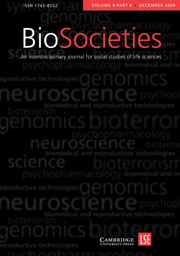Article contents
Models of Cloning, Models for the Zoo: Rethinking the Sociological Significance of Cloned Animals
Published online by Cambridge University Press: 22 December 2009
Abstract
Cloned animals are often understood as ‘models’ whose embodiments demonstrate the viability of somatic cell nuclear transfer and its applicability to a species body. In conceptualizing models through the trope of technoscience, Evelyn Fox Keller has argued that scientific models are not simply cognitive representations of something else, but are also embodiments of action and practice that constitute the kinds of scientific questions that can be asked and how those questions can be answered. Drawing on Keller’s language, I would say that, while we understand cloned animals as ‘models of’ somatic cell nuclear transfer, little empirical scholarship has explored what these animals are ‘models for’. This article asks what practices cloned animals embody, focusing on endeavours to clone endangered wildlife in the United States. Based on a multi-sited, ethnographic study, I show that these animals are models for conducting science in zoological parks, which entails questions regarding the kinds of knowledge practices that should be used to reproduce zoos and, in turn, meaningfully reconstitute wildlife. Based on this analysis, I contend that cloned animals not only model technique and scientific practices, but also new assemblages in the reproduction of zoos and, in turn, nature.
Information
- Type
- Articles
- Information
- Copyright
- Copyright © London School of Economics and Political Science 2009
References
- 11
- Cited by

